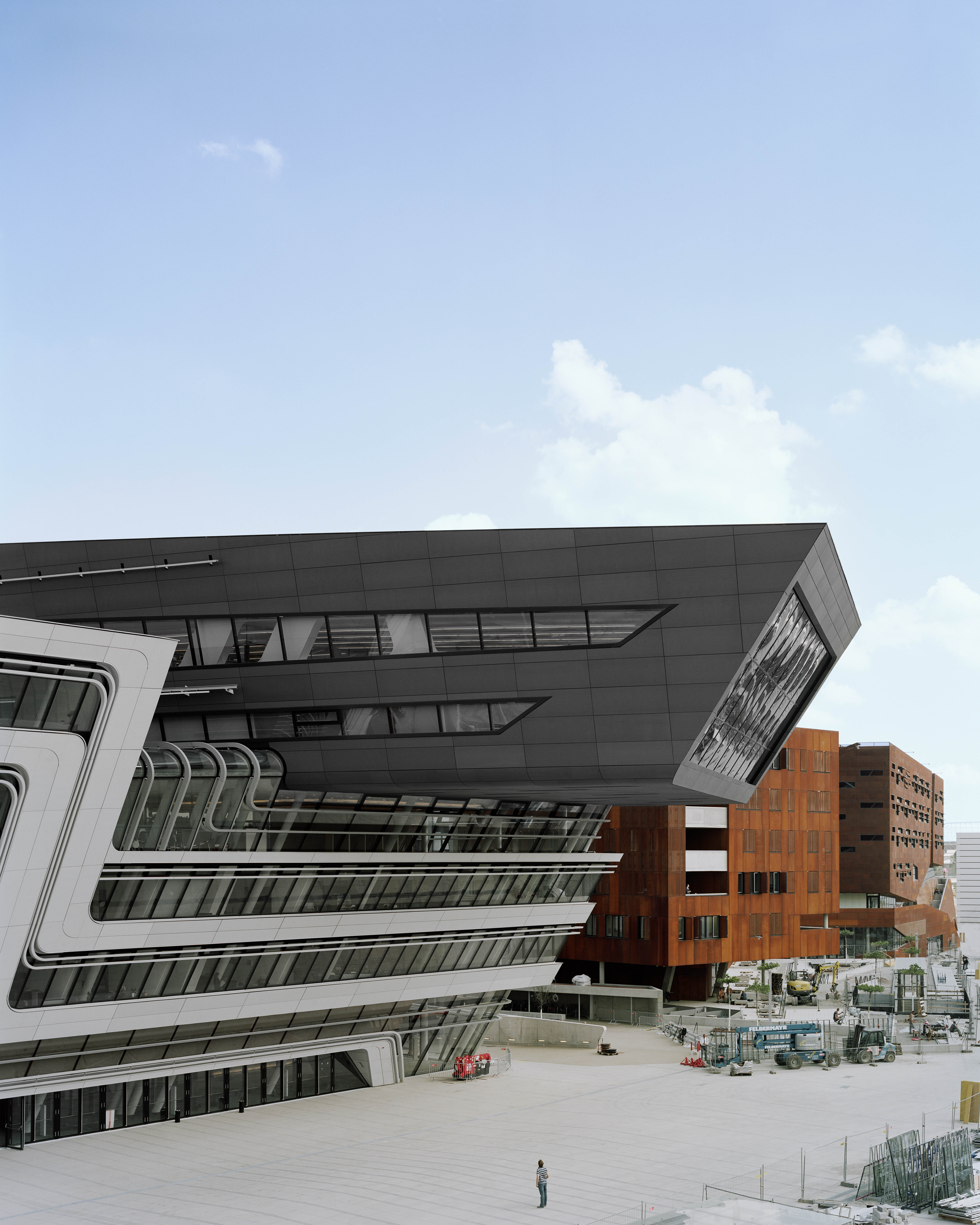Extruded Concrete Panels for Rainscreen Assembly
Learning Objectives:
- Discuss the overall durability and performance benefits of including rainscreens in commercial buildings.
- List the common materials used to produce rainscreen.
- Compare and contrast common rainscreen materials.
- Describe the manufacturing process and performance benefits of extruded concrete.
Credits:
The concept of a rainscreen appears to have originated in Norway centuries ago, where builders used the technique to protect church and barn walls with a layered structure, usually back-ventilated wood cladding that was placed over the top of a stone or wood wall, with an air gap in between. The layers—and the air gap—included open joints and promoted drainage of any moisture that entered the cladding layer.

Photo: Rasmus Norlander
Project Name: LLC Library & Larning Center, University of Vienna, Austria
Architect: Zaha Hadid
The new campus at the University of Vienna of Economics and Business is designed to accommodate 24,000 students and 1,800 staff.
Over time, the rainscreen design was modified for more modern use and was formalized as an architectural principle in 1962 by Scandinavian designer Birkeland, who took inspiration from old Norwegian barns. Later, the concept was amended in 1963 by Canadian architect G.K. Garden, who introduced the pressure-equalization concept to the design in Canada and coined the term “rainscreen.” Over the past several decades, the design principles have been tested and refined, and builders have increasingly been including rainscreen systems, commonly known just as rainscreens, as part of their building envelope. In the modern design, ventilation was built in through both top and bottom ventilation and drainage openings. These systems have been used extensively in both Canada and Europe since the 1980s. However, they have only started to become common in the United States over the past decade or so.
Rainscreen systems consist of three essential layers: the exterior cladding (the “screen”), a sealed air gap (or pressure-equalization chamber/PEC), and a water-resistive barrier (WRB) that is attached to the building’s frame. The rainscreen assembly must also include openings or vents that connect the air gap to the outside. This combination helps protect the structure by controlling external moisture (rain, snow, etc.) so that it does not reach the building’s internal substructure. The two standard rainscreen designs either drain water through the back-ventilation, as noted above, or use pressure equalization to moderate the air and moisture. Designers need to evaluate their project requirements and the environmental factors of the build site before deciding which rainscreen works best for their building.
The rainscreen itself usually refers to the actual siding, which can be made from a variety of different materials. Designers often choose the materials based on the potential impacts on the local environment (e.g., climate, pollution), the desired aesthetics, installation requirements, lifetime maintenance, and the project budget as a whole. Designers may also consider whether the panels are fire rated and if they add to the building’s green ratings. Rainscreen materials will be discussed in more detail later in this course.
When compared to other common systems, such as external thermal insulation systems (ETICS), the rainscreen has several advantages, such as moisture management and lower life-cycle costs. ETICS are wall insulation systems that are designed to provide the building with an added layer of insulation to protect against energy loss. The systems can be designed to change the face and character of the building, and consist of a base coat, a thermal insulation, adhesives, and a finishing coat. The main difference between ETICS and rainscreens is the former lacks an air gap in between the exterior and the interior, and that gap provides an added level of moisture management.
Building professionals may view the higher capital cost of rainscreens as a reason not to install them. However, the lifetime performance when compared to other alternatives show that the investment is usually worth it. Rear-ventilated rainscreens are highly efficient because of their high durability and low-maintenance design. This design, which includes an air gap between the cladding and the building substructure, means that the interior is protected, and thus has a longer life. In addition, it’s easy to add fire and lightning protection as well as noise buffers to rainscreens, thus adding to the overall benefits. ETICS systems, which lack that gap, insulate well and are useful in many situations. However, they are more prone to damage over time.
When we add in the differences between the initial manufacturing costs and ongoing maintenance costs throughout the product lifetime, the overall cost of different facades can vary. However in a head-to-head comparison, the rainscreen has features that boost its long-term performance and balance out the capital costs of the system when compared to less-durable designs.
Regardless of what kind of system designers choose, the rainscreen needs to be correctly installed. A properly installed rainscreen will help deflect water through eaves and cladding, will protect the walls by diffusing air via ventilation in the panel, and will drain any water that develops behind the cladding (for example, from condensation or seepage). The system also must dry any moisture and be durable enough to withstand environmental conditions and time.









